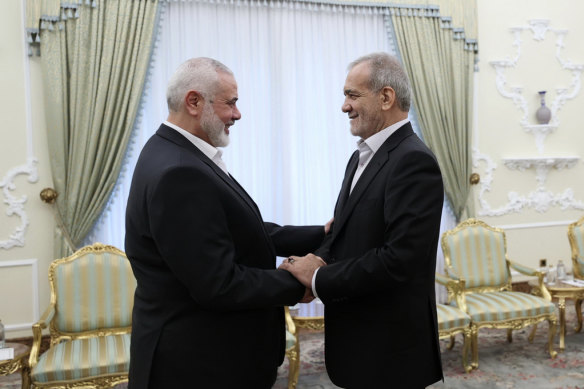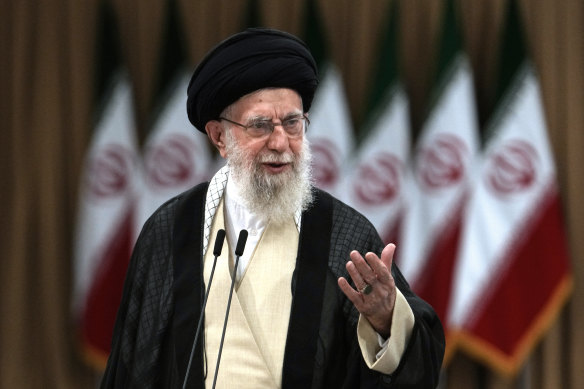This was published 7 months ago
A new leader, an assassination and the nuclear option: Why world is sweating on Iran
By David E. Sanger and Farnaz Fassihi
Most new Iranian presidents have months to settle into the decades-old cadence of gradual nuclear escalation, attacks against adversaries and, episodically, secret talks with the West to relieve sanctions.
President Masoud Pezeshkian had 10 hours.

Iran President Masoud Pezeshkian, right, shakes hands with Hamas chief Ismail Haniyeh, who was killed by Israeli Defence Forces on Wednesday, hours after Pezeshkian’s swearing-in.Credit: AP
That was the elapsed time between his swearing-in and the explosion inside a Revolutionary Guard guesthouse, at 2am in Tehran, that killed Ismail Haniyeh, long-time political leader of Hamas. Haniyeh had not only attended the swearing-in, but had also been embraced by the new president and met that day with the supreme leader, Ayatollah Ali Khamenei, making the assassination a particularly brazen act.
Now Pezeshkian – along with Khamenei and top military generals – will be immersed in critical choices that may determine whether war breaks out between two of the Middle East’s most potent militaries. He spent his first day in office in national security meetings. The final decision on how to retaliate rests with Khamenei, and on Wednesday he ordered Iranian forces to strike Israel directly for what appeared to be its role in killing Haniyeh.
But how that retaliation unfolds makes a difference. If Iran launches direct missile attacks, as it attempted for the first time in 45 years in April, the cycle of strike and counterstrike could easily escalate. If Hezbollah, its closest ally in the region, steps up attacks on Israel’s north or the Houthis expand their attacks in the Red Sea, the war could expand to Lebanon, or involve the need for US naval forces to keep the sea lanes open.
Behind all of those options is perhaps the riskiest choice of all: whether Iran decides to take the final step toward building a nuclear weapon. For decades, it has walked up to the line, producing nuclear fuel and in recent years enriching it to near bomb-grade levels. But US intelligence assessments say the country has always stopped short of a weapon, a decision Iranian leaders have publicly been reconsidering in recent months.

Iranian Supreme Leader Ayatollah Ali Khamenei.Credit: AP
The temptations for revenge are obvious. Assuming that the assassination of Haniyeh was engineered by Israeli intelligence operatives – the Israelis have refused to either acknowledge or deny a role – the attack was designed as more than just a strike against a senior Hamas leader. It was a humiliation of the Iranian government, the latest reminder of how deeply the Israelis have penetrated Iran’s security apparatus.
“This attack was a huge slap in the face for Iran’s status in the region,” Ali Akbar Behmanesh, a prominent politician and a leader of Pezeshkian’s campaign, said in an interview. “It humiliated our country and undermined our entire security apparatus, showed that we have serious holes in intelligence.”
As one senior US official noted Wednesday, the Israelis could have killed Haniyeh, one of the main interlocutors on a ceasefire and prisoner-exchange deal that appears imperilled again, anywhere in the Middle East.
The official noted that the Israelis chose to do it in Iran during the inauguration. Foreign dignitaries from more than 80 nations were at the ceremony, where security was tight. The message was obvious. The assassins were not only retaliating against Hamas leaders for the October 7 terror attack in Israel that killed more than 1100 civilians, but were also reminding Iran’s new leaders that they, too, were within easy reach.
But as Pezeshkian is bound to discover as Iran considers its options, measuring the right response without tipping the country into a devastating war, is no easier for the new president than it was for the previous eight men who have held the office since the Iranian revolution.
“The attack injects a major crisis for Iran’s new president on his first day on the job,” Ali Vaez, head of the Iran project at the International Crisis Group, said on Wednesday. “Pezeshkian ran on a pledge to rebalance Iran’s foreign relations” and to relieve sanctions, a vow he made in his inauguration address to the country.
“A regional escalation against a key US ally will shut the already extremely narrow window there might have been for diplomatic engagement,” Vaez said.
In truth, that window was all but shut before the killing.
Iran was engaged in indirect negotiations with the Biden administration in 2021 and 2022, and at moments the two sides seemed close to reviving some version of the 2015 nuclear deal, which put sharp limits on Iran’s nuclear fuel production, in return for sanctions relief. As president, Donald Trump pulled the US out of the agreement in 2018.
But President Joe Biden’s effort to fashion a new accord collapsed in talks with the government of President Ebrahim Raisi, who died in a helicopter crash in May. With the American presidential election so close – and the prospect of Trump’s return to office – the Iranians had little incentive to revive the conversation.
For Pezeshkian, the news that a key ally and a guest at his inauguration was killed was also a personal blow, according to two members of his advisory committee who spoke on the condition of anonymity because they were not authorised to speak on the record.
He emerged from an emergency meeting with Khamenei and members of Iran’s Supreme National Security Council to accuse Israel of staging the attacks. “We will make the occupying terrorist regime regret its action,” he said in a statement.
But attending the meetings and influencing the decision-making on retaliation are different. It is unclear that a man who was elected to relieve social tension, touting a platform of liberalising social rules on wearing the hijab and use of the internet, will have influence over the Revolutionary Guard, which was particularly humiliated by the strike. Pezeshkian has said that he fully backs Iran’s state policy toward Israel and supports the militant groups in the region.
“My sense is Pezeshkian will not have an impact on the decision,” said Suzanne Maloney, vice president and director of foreign policy at the Brookings Institution and a long-time Iran expert. “He was never a part of the inner circle on security.”
Maloney said it was possible that the supreme leader, in ordering a direct retaliatory strike on Israel, meant a missile attack – similar to what it attempted April 13, its biggest and most overt attack on Israel since the 1979 Iranian revolution. It launched hundreds of missiles and drones in retaliation for an Israeli strike on its embassy compound in Damascus, Syria, which killed several Iranian military commanders.
But even that show of force was telegraphed well in advance. General Michael E Kurilla, who heads US Central Command, had time to organise a comprehensive missile defence that included US, Israeli and Jordanian forces, among other allies. Nearly all the weapons were shot down and little damage was done.
Now the United States is likely to try to assemble that coalition – which some US officials describe as a nascent NATO-like defensive alliance – to fend off another attack in days or weeks. They will urge the Israelis not to escalate when and if an attack comes, noting that in April, the fears of a regional war dissipated after Israel dropped a few weapons into Isfahan, Iran, while keeping them far from the nuclear sites surrounding that city.
Other forms of retaliation could also follow. While US officials believe that neither Israel nor Hezbollah wants a war on the territory of Lebanon, the possibilities for an accident or overreaction are ripe.
The riskiest move would be crossing the line from developing fuel for a nuclear weapon to developing the weapon itself. “Instead of being at least a year away from having breakout capacity to produce fissile material for a nuclear weapon, they’re probably one or two weeks away from doing that,” Secretary of State Antony Blinken said on July 19 at the Aspen Security Forum. “Where we are now is not a good place.”
Blinken and Jake Sullivan, the national security adviser, both said they had yet to see a political decision to move toward making a bomb. But they noted the increasing conversation among Iranian leaders about that possibility.
“I have not seen a decision by Iran to move” in a way that signals Iran was definitely developing a weapon, Sullivan said at the same event. “If they start moving down that road, they’ll find a real problem with the United States.”
This article originally appeared in The New York Times.
Get a note directly from our foreign correspondents on what’s making headlines around the world. Sign up for our weekly What in the World newsletter.